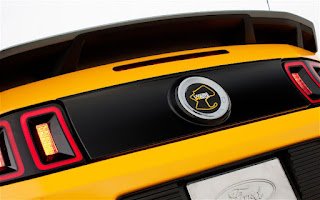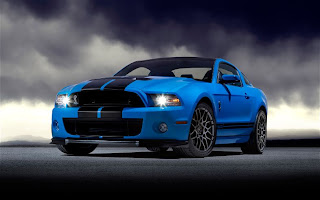2013 Ford Shelby GT500 and 2013 Mustang Reviews
With newest auto technology once again Ford launch new product, that is 2013 Ford Shelby GT500 and 2013 Mustang. What improvements have been made to Ford cars over the years?
The 2013 Ford Shelby GT500 produces 650 hp and 600 lb-ft of torque from its supercharged 5.8-liter V-8, and can reportedly top out at more than 200 mph. Yes, we said 200 mph. With the GT500, Ford has put the Bow Tie boys on notice -- the Blue Oval is gunning for the 580-hp Camaro ZL1, so they'd better duck and cover.
While the super Shelby with its outrageous power output is the marquee Mustang attraction, the rest of the 2013 Ford Mustang lineup has been updated as well. The headlines? New hoods, grilles, headlights, more track-related goodies, an available select-shift automatic, and 420 hp from the GT's 5.0-liter V-8.
For the GT500, Ford's SVT performance engineers went big. Real big. To start, the GT500's 5.4-liter all-aluminum V-8 was bored out to displace 5.8 liters; the block and heads were cross-drilled; and the camshaft profiles updated, among other changes. Next, SVT bolted on a new Eaton TVS Series 2300 supercharger (the same
supercharger GM uses on its LS9 engine) to the 5.8-liter mill. Add in a larger cooling fan, a higher-flowing intercooler pump, and a larger intercooler heat exchanger, and you get the GT500's 650 hp and 600 lb-ft of torque, and a top speed north of 200 mph.
Ford says the GT500's new engine is the most powerful production V-8 in the world, but that depends on your definition of "production." Taken literally, both the V-8-powered Koenigsegg Agera R and SSC Ultimate Aero TT best it, producing more than 1000 horsepower each. But if you define production as mass production, then Ford's statement rings true. Its closest competitor would be the Corvette ZR1, which produces only 638-hp and 4 more pound-feet of torque.
Anyone will tell you that the problem with the previous Shelby GT500 wasn't a lack of power -- it was actually putting that power down to the ground. The previous GT500's performance numbers were often traction-limited, resulting in a 0-60 time not much better than the Mustang GT. To deal with this problem, SVT engineers revised the six-speed manual transmission's gearing in an effort to make the GT500's power more usable. SVT ditched the 3.55 final drive ratio for a 3.31 final drive, and then optimized every gear (except fourth) to better use the newfound torque. SVT further beefed up the drivetrain with a dual-disc clutch and carbon-fiber drive shaft.
Ford rounds out the GT500s performance specs with an SVT-designed launch control system, and new Brembo brakes. The Shelby's new brakes are six-piston in front, and have larger rotors both front and rear to aid in the fight against brake fade.
For those interested in even more performance, Ford will also be offering two performance packages for the Shelby GT500. The Performance Package will include a Torsen limited-slip differential, and an SVT-designed Bilstein suspension system. The Bilstein suspension includes electronically adjustable dampers with two driver-selectable modes: Normal and Sport. Ford says Normal will allow for a more comfortable ride in shoddy road conditions, while Sport will tighten the suspension up, further minimizing body roll and pitch at the track.
Also available when you tick the Performance Package option is the Track Package, which builds on the Performance Package by adding an external engine cooler, rear differential cooler, and a transmission cooler to fight heat soak in high speed and track conditions. The 3850-pound GT500 rides on second-generation Goodyear Eagle F1 SuperCar tires mounted on 19-inch front and 20-inch rear forged aluminum wheels.
While a 650-hp V-8 has a lot to do with the Shelby GT500's newfound 200-mph top speed, aerodynamics play a huge role as well. The 2013 GT500's front fascia was designed to not only maximize cooling to the 5.8-liter mill, but also to maximize downforce while minimizing drag. To accomplish this, SVT's engineers modified the GT500's front end with a new front splitter and downforce-generating front grilles. Ford says that in designing the GT500's aero to deal with the stress of 200 mph, it also improved the car's feel all around so it remains more planted at all speeds. To put a number on the aero changes, Ford says the 2013 GT500 is 33 percent more planted at 160 mph compared to the outgoing model.
The 2013 GT500s face-lift wasn't just restricted to aero improvements. As mentioned, the GT500 gets a new, thick, aggressive-looking front splitter that melds well with the GT500's new grille -- or lack thereof. The new GT500 loses the old grille in exchange for two gaping intakes. The only "grille" to speak of are four strakes (two on the corner of each intake) that work to increase airflow to the new engine.
The GT500 also gets exterior changes that carry over to the rest of the 2013 Mustang lineup. All 2013 Mustangs now get standard HID halo headlights with two LED bars, lending the Mustang a more aggressive, modern look. The LED treatment continues around back, where all Mustangs get new taillights. The Mustang's triple taillights gain a smoked appearance and circular LEDs that surround the newly concave design.
The exterior changes don't end there. Up front, the 2013 Mustang loses the gaping lower intake for one that's more graceful. The new lower intake mirrors the Mustang's distinctive upper intake, and features new splitters protruding from either side that probably don't do much for aerodynamics but sure look good. The face-lift also sees the Mustang losing the black trim surrounding the grille for body-colored trim, and gaining a retro-inspired black panel on the trunk visually linking the two taillights.
One of the few areas were Ford's engineers stepped away from tradition can be seen on the Mustang GT and Boss 302's new hood. While many previous Mustangs got gills and scoops that were all show and no go, the GT and Boss' new hood features gills mounted near the cowl that actually have two functions: looking cool, and extracting heat from the engine bay.
The rest of the visual changes to the 2013 Mustang are strictly cosmetic. The Mustang and Mustang GT get an optional "pony projection light" that projects the Mustang's signature prancing pony emblem on the ground when the doors are unlocked at night. Talk about showing off. Base Mustangs and Mustang GTs get two new colors, Deep Impact Blue and Gotta Have It Green, while the Boss 302 gets a unique new color too, called School Bus Yellow.
The other cosmetic changes are Boss-specific. In addition to the new paint, the 2013 Boss 302 also gets a new, reflective hockey stick graphic that pays homage to its 1970 Boss 302 predecessor. Black or School Bus Yellow Boss 302s also gets Sterling Grey accents this year on the grille, mirror, and spoiler. The new Boss also loses the love-it or-hate-it, color-accented roof and loud red wheels for a body-colored roof and gray and silver wheels.
The visual changes aren't just limited to the 2013 Mustang's exterior, as the inside gets a modest update as well. Newly optional on all Mustangs are the fantastically snug Recaro seats from the Boss 302, now available in cloth or trimmed in leather. The Mustang's instrument panel gets a light retouching, with new easier-to-read graphics, a new 4.2-inch screen located between the speedo and tach, and a gas gauge and oil temp gauge relocated to the tach's display.
Speaking of that new 4.2-inch screen, Track Apps are now available on the 2013 Mustang. Similar to the F-150's Truck Apps, the Mustang's Track Apps allow drivers to monitor performance metrics that they'd otherwise need specialized equipment for. An on-board accelerometer allows Track apps to measure the car's g force as it pulls from left to right while turning, or fore and aft while accelerating and braking. Track apps can also measure 0-30 mph, 0-60 mph, and 0-100 mph times, and for drag racers, eighth-mile and quarter-mile times. All five of those metrics can be initiated with a virtual drag racing start light, so Mustang drivers can hone their skills off the track. There's also a Brake Performance screen, where 60-0 mph and 100-0 mph stopping distances can be measured.
What good are Track Apps without added performance? For 2013, the Mustang GT's 5.0-liter V-8 gets a power boost from 412 hp to 420 hp, thanks to lessons Ford engineers learned while developing the Boss 302's 444-hp engine. The Mustang GT also gets a new option, the GT Track Pack. Available only with a 3.73 axle, the GT Track Pack builds on the Brembo Brake Package and further upgrades the GT for track use, adding such goodies as an engine cooler, upgraded radiator, performance brake pads, and the Torsen differential from the Boss 302. Think Boss on a budget.
Previously only available on manual-equipped Mustangs, the Brembo Brake Package and the V-6 Performance Package are both now available on automatic-equipped Mustangs. Speaking of which, Ford has decided to include SelectShift with the Mustang's six-speed automatic transmission. Controlled by a button on the side of the new shifter, SelectShift will allow drivers of those Mustangs to manually control what gear the car is in, without the ECU attempting to override the driver's wishes. Manual-equipped Mustangs get a new toy too, as hill-start assist is now standard for 2013.
The best part about the 2013 Ford Mustang lineup though is that you don't have to wait until the end of next year to see it, as Ford will be rolling it out this coming spring. With an all-new Mustang arriving just in time for its 50th anniversary in 2015, this update will likely be the last we'll see for the current pony.
2013 Ford Shelby GT500 and 2013 Mustang Pics Gallery
Here are best high quality photos for 2013 ford escape2013 Ford Shelby GT500 and 2013 Mustang in every angle that allow us to see the whole details of this new favorite cars product.
Subscribe to:
Posts (Atom)

















































